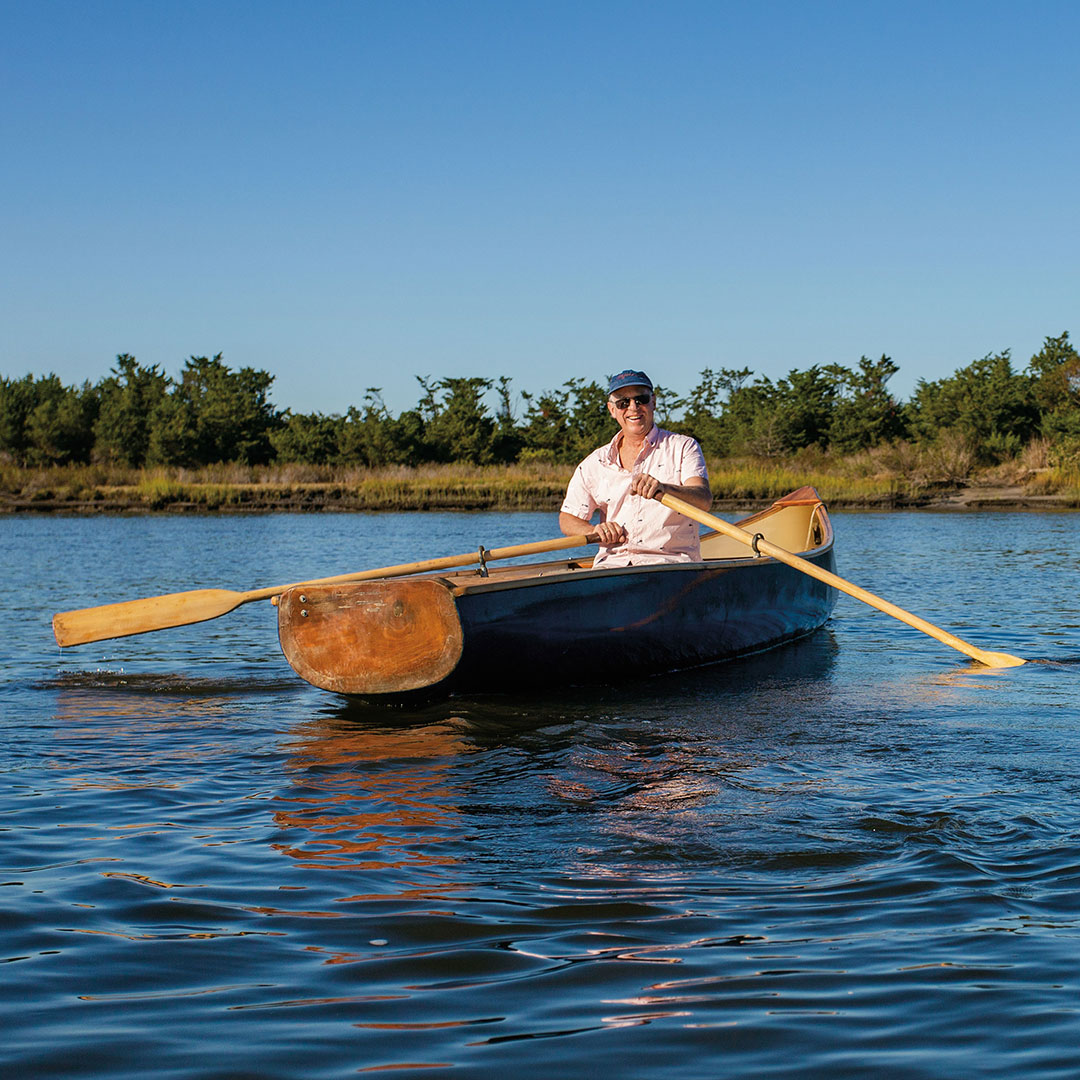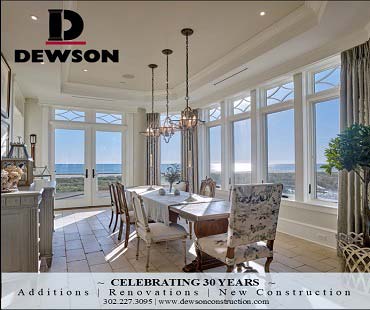
Local boatbuilders ride a 600-year tide of history
By Bill Newcott | Photographs by Carolyn Watson
From the Holiday 2019 issue

The 20-foot-long, cobalt-blue lake canoe occupies much of the length of David Greenhaugh’s driveway. Even to a guy who doesn’t know a dinghy from a deck boat, the workmanship is striking, the artisan’s attention to detail unmistakable.
Just above the bow, the canoe’s triangular deck plate — made of hard cherry wood — is stained like a fine piece of living room furniture. Inside the canoe, the gloss of white paint is smooth enough to see my reflection.
Between the white inside and blue exterior, embedded in the long, sweeping starboard gunwale at the top of the hull, a thin red strip of stained wood runs its entire length. This is the only evidence that the shell of this canoe is constructed entirely of redwood.
“I cut the strips myself in my workshop,” Greenhaugh says, running his hand along the smooth ridge.
I imagine him setting to work on a pile of choice lumber. In my mind’s eye he hews long lengths of virgin redwood, freshly timbered from the American Northwest.
Then he interrupts my reverie.
“It used to be a pickle barrel,” he says.
Assuming this is some sort of nautical joke,
I laugh.
“No, really,” he smiles. “I found this huge old pickle barrel in Atlanta, about 14 feet in diameter and probably 10 feet deep. It took many truckloads to get the wood up here.
“I cut it down into strips. I narrowed it into a quarter-inch by five-sixteenths, I guess. And I started from there.”
With painstaking precision and unfathomable patience, Greenhaugh glued each flexible strip onto a frame. When the last piece was set in place, he had a canoe.
He bends a bit, tilting his head so his eye can trace the gentle arc of the gunwale.
“It’s a good boat,” he says. And Greenhaugh should know. He’s owned “eight or 12” boats and built three of them.
If you want to know how long they’ve been building good boats in this region, look no farther than the Lewes History Museum. There, behind a glass panel, you’ll find the remains of a 600-year-old dugout canoe, discovered in a local marsh. It’s typical of the canoes built by the Nanticoke people, and as the name suggests, it was crafted by literally digging out the trunk of a felled tree.
The broad tree-trunk canoes of Dela-ware’s native peoples were the precursors to later fishing and hunting boats built by subsequent generations of coastal Delawareans. Also in the Lewes History Museum is a broad-bottomed 1910 Delaware Ducker, shallow enough to negotiate the local wetlands and stable enough for a hunter to stand on its deck and fire a shotgun atflying fowl.
Variations of the Delaware Ducker plied the swampy coastal waters up and down the Eastern Seaboard. Most were built by their owners after eyeballing a neighbor’s boat, so in a nautical version of the whispering game Telephone, the details of each craft could be subtly different. That’s how an expert can tell the difference between a New Jersey Ducker and a Delaware one.
In the mid-1600s, before Lewes got its name, a Dutch shipwright named Cornelis Verhoef was hammering away off the waters of Canary Creek. By 1683 — after William Penn claimed the three counties on the Delaware River and bay as part of Pennsylvania — the Brits had gotten in on the act. Shipwrights William Beverly and John Brown began launching new boats into Lewes’s natural harbor, the creek below what is now Shipcarpenter Street, which is today the Lewes-and-Rehoboth Canal.
Shipbuilding in Lewes really took off in the 18th century, with three or four major shipyard operations — including one operated by Cato Lewis, a former African slave who had bought his freedom, and his son Peter — turning out moderate-size ships, including at least one major schooner capable of carrying up to 72 tons of cargo. Where today children swing in the playground and couples walk arm-in-arm on the graveled paths of Canalfront Park, for centuries burly guys toiled, tools in hand, over the growing frames of ships under construction.
It took a lot of lumber to build those ships, and there were plenty of trees growing right nearby. But deforestation led to land erosion, which accelerated silting of the creek. The water became too shallow for launching larger craft, so by the late 1800s the center of Sussex County shipbuilding had shifted up the Broadkill River to Milton. Lewes never reclaimed the shipbuilding fame it once had.
But that was just a stopgap strategy: The die had been cast for the local ship industry. Coastal Delaware’s rivers were too silted, the channels too shallow, the demand for ever-larger vessels too insistent. The professional shipbuilders moved on, leaving empty shorelines and, in all likelihood, layers of bottles, coins and tools sinking in the sediment below their old worksites.
The shipyards may have vanished from coastal Delaware, but the shipbuilders never did. Hunters still crafted their duck boats. Crabbers still built their skiffs. And still others, dipping into that primeval urge to become one with the sea, simply built boats because, well, that’s how you get out onto the water.
That’s what drives David Greenhaugh, the man with the 20-foot canoe in his driveway. We shake hands — my spindly writer’s fingers disappearing into the mitts of a guy who makes his living as a mechanic. After I’ve admired his workmanship, he invites me inside for a cup of coffee.
Appropriate to the location of his house just off Pilottown Road, Greenhaugh is a former river pilot. A lifelong resident, for years he helped guide ships as they ventured beyond Cape Henlopen and up the Delaware.
As the morning sun reflects off the Lewes-and-Rehoboth Canal outside his front room window, Greenhaugh tells me he built his first boat about 15 years ago. Like the canoe outside, it was strip-built: made of small pieces of wood glued together and stapled onto a frame.
“Next, I built a dinghy for that boat,” he says, indicating a painting on the wall behind me. I turn to see the image of a handsome wooden fishing boat moored to a rocky shoreline. And sure enough, standing on its side at the aft end is a dinghy. The large boat has long since been sold and now resides in New England.
“The dinghy is down in the basement,” he says, and he takes me downstairs to visit it.
Mounted hull-up on two wooden benches in Greenhaugh’s spotless basement is the vessel, a rounded rowboat small enough to sit on the deck of a bigger vessel.
“The larger boat was named Rain Dog, and the dinghy is named Pup,” he says, tilting it to one side. “This one’s built of plywood. I put these steps here so my dog could get in and out. I can just about get it through that door over there.”
Greenhaugh’s masterpiece, though, is that long, wide-bottomed beauty in the driveway. Her name is Ora, and she’s similar in size to ones in which the Iroquois once plied the waters of Lake Champlain.
“I built it because I had paddled a 14-foot canoe down the Broadkill one February, and my dog kept jumping from one side to the other to see birds. I thought I was gonna tip! So I decided to build a canoe that wouldn’t flip over.”
He spent about 500 hours crafting Ora over a six-month period.
“When you’re building a strip boat like that, you work on it piece by piece,” he says. “You can work on it for a half-hour and then take days off — or you can work on it for days and take a half-hour off.”
For Greenhaugh, building a boat is a means to an end: getting it into the water and setting off in it.
“The best thing about building a boat is finishing it,” he says.
***
There’s no doubt Neil Stevenson loves sailing on the boats he builds, but one look at his meticulously drafted plans — with finely drawn lines and hundreds of intricate notations accurate to a quarter of an inch — and you know the process of creation is every bit as precious to him.
We are standing at Stevenson’s drafting table in a well-lit room at the rear of his house in Anne Acres, just west of Rehoboth Beach. It’s the house of a boatbuilder; a wide-open space with beautifully finished, bare wooden beams that resemble below decks on a 19th-century frigate. And there’s not a nail to be seen: Stevenson built the entire house using pegs.
“I’ve built about 12 boats,” he says. “I still have some of them, including the best one I ever built: a 22-foot tri-hull. That’s on a trailer. I’ve got a 25-foot catamaran at anchor. I have a motorboat in the yard.
“I also built a 12½-foot Herreshoff tender that I have out back. It’s a real classic design, the kind the Herreshoff company would build for you if you got one of their yachts. When I sailed to Florida on my 32-foot tri-hull, I had that tender on the deck, and these guys in million-dollar sailboats would all yell, ‘Nice boat!’ They weren’t talking about my tri-hull; they were talking about my tender.”
Stevenson, a lifelong surfer who spent years working on pilot boats, has been sailing for four decades — most often his own boats, but frequently transporting other people’s crafts. He’s a living encyclopedia of boat engineering, freely quoting Howard I. Chapelle, author of the recognized bible of boatbuilding. He holds forth on the benefits of epoxy resin over polyester glue for affixing slats. But after all the prevailing and classic design theories have been consulted, for Stevenson it all comes down to one thing: Does it look right?
“I’ve read Chapelle cover to cover, all about lofting and measurements and diagonals,” he says. “I say, ‘Nah, that’s too much trouble.’ I just take a flexible wooden baton and bend it until it looks right, and then build from there.”
He’s a big fan of trial and error, too.
“For my first boat, I just started bolting together pieces of junk boats. Built it from scratch. It was a really cool boat, but it was a failure — it didn’t have enough floatation or wave clearance.”
When he’d scraped together enough spare money from his work in construction and as a handyman, in 2002 Stevenson got busy building his second boat.
“I took into account all the failures of my first boat, and the second boat was a success,” he says. “That’s the one I think is my best ever.”
His eyes fixed on his latest design — a project that’s been gestating for a couple of years now — Stevenson considers whether his heart is most set on sailing boats or building them.
“Honestly,” he finally says, “I guess I’m more interested in figuring it out.”
***
Bob Reed rolls up the garage door to his workshop, located below a rental house he owns near the Rehoboth Beach maintenance yard. Like the other boatbuilders I’ve met, Reed’s projects unfold at a site remote from his home near Rehoboth. As the door slides up, the smell of untreated wood floats through my nostrils.
I immediately see three boats — two smaller wooden ones and, toward the back, a fiberglass sailing craft.
“I built this little hunting boat and this tender,” he says. The latter is a striking small boat, painted white inside and out. Seen from the rear, the profile of each individual glued plywood strip is clearly visible. Each one flares out a bit, making the two sides resemble the outline of an angel’s wings.
“I ‘scarfed’ the planks together,” he says. “You can scarf two pieces of wood by tapering them, so if you have two half-inch-thick pieces of wood you taper them from full thickness to nothing. Then you put the two pieces together and use epoxy to glue them.”
Reed built the boat 10 years ago. I mention that it still looks seaworthy. “Eh, I don’t really have a lot of confidence in it,” he says. “Epoxy has a tendency to unzip — molecule by molecule it just comes apart.”
So, we won’t be going out in that one. He would, however, trust the hunting boat, a little number he built nearly 20 years ago.
“It’s cedar on frame, and rather than caulking the joints I put epoxy and cloth on it all the way around” he explains. “You’d carry it in a larger boat, or [tow] it behind you, into the marsh until the water got too shallow. Then you’d get into this one, paddle off with a handful of decoys, and go huntin’.”
By now I am realizing a surprisingly large percentage of boats are built to go on the backs of other boats. Reed’s hunting boat would certainly fit inside the 20-foot skiff I see out in the driveway, the magnum opus of his boatbuilding career.
“Basically, I just took the lines of a Down East lobster boat and re-drew them and adapted them to my needs,” he says, pulling a tarp back to reveal the deck, with its wheel console set in the middle.
“It’s like those guys on the Eastern Shore for all these years, building their own boats just to make a living. They didn’t have the money to pay somebody else to design their boats or build their boats. They fished in the summertime, and in the winter, if they needed a boat, they had to build it.”
As a guy who has bought boats and built boats, Reed is able to compartmentalize the two pursuits.
“I look at it as any job,” says Reed, who co-owns a Rehoboth Beach real estate company with his wife, Debbie.
Quickly he adds, “But I’m not getting paid for this one. I like to build things. When I was young I worked as an electrician’s helper and built furniture, and then started building houses.
“Whenever you accomplish something there’s a sense of fulfillment, and that is a reward in itself.
“But I’ll tell you what. If I could find a commercially made boat that performed like my 20-foot skiff here, I would buy it.”
There’s a quiet verging on library-esque in Freddie’s Barn, the former workshop of the Lewes Historical Society’s longtime handyman, the late Fred Hudson. Cleared of all the clutter Fred left behind, the barn on the organization’s Lewes campus is now a dedicated shipbuilder’s shed.
“I think Fred would be proud,” says Marcos Salaverria, director of education for the historical society — who, along with society researcher Andrew Lyter, has uncovered much of the area’s shipbuilding history.
In its 10 years of existence, the LHS’s wooden boatbuilding program — created to sustain the region’s long nautical history — has produced some 40 vessels. Most of them have been small boats, but in 2017 the group’s replica of a Delaware Ducker — modeled after the original that sits in the Lewes museum — won the People’s Choice Award at the Chesapeake Bay Maritime Museum’s Small Craft Festival in St. Michael’s, Md.
“It was quite something for a Delaware boat to win at a Maryland festival,” Salaverria says with some satisfaction.
On this day, 11 volunteers — 10 men and one woman — huddle around the hull of another large boat, a 16-foot sharpie. It’s a flat-bottomed, shallow sailboat that was first developed in Connecticut during the 19th century but, over time, became a mainstay of Chesapeake Bay oystermen.
The volunteers are painting the interior of the hull white to protect the Philippine mahogany wood from damage. The exterior will be coated with penetrating oil to preserve its natural color.
“Don’t dab the paint — brush it in,” Bob Kotowski, a former Newark-area journalist and Philadelphia newscaster, cautions a volunteer. He showed up for the group’s organizational meeting in 2009 and has been a boatbuilder ever since.
About nine months ago, this boat was a pile of wood. The crew, which convenes here twice a week — two or three hours on Tuesdays and Thursdays — is not quite halfway through the project. As with the ducker, the plan is to take the sharpie to schools and events to educate people about coastal Delaware’s boatbuilding history.
To my untrained eye, this vessel looks almost ready to set sail. Why is it going to take the better part of a year to finish it?
“Oh, jeez,” sighs Kotowski, and immediately I know that was a stupid question.
“This boat is going to need ribs on the inside, something in the neighborhood of 46 of them,” he explains with admirable patience. “If we put the ribs in first, then we’d have to paint around them, because we want them to keep their natural color. Then we’ve got to do a bazillion deck beams. We’ve gotta make a skeg, we gotta make a keel, we gotta make a centerboard, we gotta make the transom. And we’ve gotta make the mast, which is a real long process.
“So, yeah, a year is about right.”
All the time he’s talking with me, Kotowski’s eyes dart repeatedly back to the work in progress. He clearly likes talking about boatbuilding, but he’d rather be building than yakking.
“You’re still dabbing,” he finally says to a volunteer, and then he’s off to show them all how to do it.
I leave the cool shade of Freddie’s Barn and step into the hot, late-summer sun. To my right, a lineup of historic houses, brought here over the years for safekeeping, stretch into the distance like a Colonial Levittown. As I walk alongside the timbered frames I can still hear the fading chatter of boatbuilders’ voices and the soft thumps and scraping of boatbuilders’ tools.
They seem very much at home.



